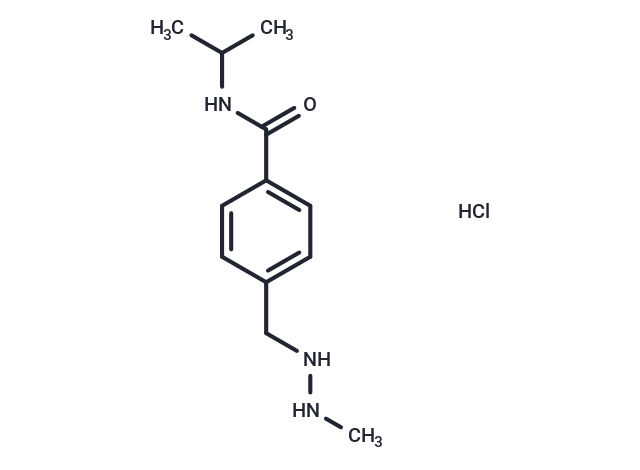 Your shopping cart is currently empty
Your shopping cart is currently empty

Procarbazine hydrochloride (NSC-77213 HCl) is the hydrochloride salt of a methylhydrazine derivative with antineoplastic and mutagenic activities. Although the exact mode of cytotoxicity has not been elucidated, procarbazine, after metabolic activation, appears to inhibit the trans-methylation of methionine into transfer RNA (t-RNA), thereby preventing protein synthesis and consequently DNA and RNA synthesis. This agent may also undergo auto-oxidation, resulting in the formation of cytotoxic free radicals which damage DNA through an alkylation reaction.

| Pack Size | Price | USA Warehouse | Global Warehouse | Quantity |
|---|---|---|---|---|
| 50 mg | $30 | In Stock | In Stock | |
| 100 mg | $39 | In Stock | In Stock | |
| 500 mg | $84 | - | In Stock | |
| 1 g | $122 | - | In Stock | |
| 1 mL x 10 mM (in DMSO) | $43 | In Stock | In Stock |
| Description | Procarbazine hydrochloride (NSC-77213 HCl) is the hydrochloride salt of a methylhydrazine derivative with antineoplastic and mutagenic activities. Although the exact mode of cytotoxicity has not been elucidated, procarbazine, after metabolic activation, appears to inhibit the trans-methylation of methionine into transfer RNA (t-RNA), thereby preventing protein synthesis and consequently DNA and RNA synthesis. This agent may also undergo auto-oxidation, resulting in the formation of cytotoxic free radicals which damage DNA through an alkylation reaction. |
| In vitro | Procarbazine plus Cu(II) induce piperidine-labile and formamidopyrimidine-DNA glycosylase-sensitive lesions at the 5'-ACG-3' sequence, complementary to a hotspot of the p53 gene, and the 5'-TG-3' sequence. Procarbazine causes DNA damage through non-enzymatic formation of the Cu(I)-hydroperoxo complex and methyl radicals. [1] Procarbazine has a strong clastogenic effect in hematopoietic cells and is mutagenic in a variety organs after high dose treatment. [2] |
| In vivo | Procarbazine causes significant decrease in testicular and epididymal weight and a drastic reduction in haploid cells and spermatogenic arrest, demonstrating variation among the test golden hamster. [3] Procarbazine produces a dose-dependent potentiation of MAO A in brown adipose tissue, the elevation being more pronounced following monomethylhydrazine, with activity rising to 350% of that in control homogenates in rats. Procarbazine or monomethylhydrazine reduces metabolism of this amine by a similar degree as had been determined ex-vivo in blood vessel homogenates. [4] Procarbazine is mutagenic, clastogenic and teratogenic in a wide range of test systems of varying complexity and a wide-spectrum carcinogen in rodents and monkeys, causing tumours of the haemopoietic system, the mammary gland, the lung and the nervous system. Procarbazine in vivo undergoes a complex series of metabolic changes that result in the generation of a number of chemically reactive species, including methylating agents and free radicals. [5] |
| Synonyms | Procarbazine HCl, NSC-77213 HCl |
| Molecular Weight | 257.76 |
| Formula | C12H19N3O·HCl |
| Cas No. | 366-70-1 |
| Smiles | c1(C(=O)NC(C)C)ccc(cc1)CNNC.Cl |
| Relative Density. | 8.3 g/cm3 |
| Storage | Powder: -20°C for 3 years | In solvent: -80°C for 1 year | Shipping with blue ice/Shipping at ambient temperature. | ||||||||||||||||||||||||||||||||||||||||
| Solubility Information | H2O: 48 mg/mL (186.22 mM), Sonication is recommended. DMSO: 45 mg/mL (174.58 mM), Sonication is recommended. Ethanol: 22 mg/mL (85.35 mM), Sonication is recommended. | ||||||||||||||||||||||||||||||||||||||||
| In Vivo Formulation | 10% DMSO+40% PEG300+5% Tween 80+45% Saline: 2 mg/mL (7.76 mM), Sonication is recommended. Please add the solvents sequentially, clarifying the solution as much as possible before adding the next one. Dissolve by heating and/or sonication if necessary. Working solution is recommended to be prepared and used immediately. The formulation provided above is for reference purposes only. In vivo formulations may vary and should be modified based on specific experimental conditions. | ||||||||||||||||||||||||||||||||||||||||
Solution Preparation Table | |||||||||||||||||||||||||||||||||||||||||
Ethanol/DMSO/H2O
DMSO/H2O
| |||||||||||||||||||||||||||||||||||||||||
| Size | Quantity | Unit Price | Amount | Operation |
|---|

Copyright © 2015-2025 TargetMol Chemicals Inc. All Rights Reserved.